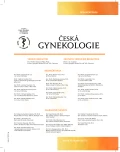-
Medical journals
- Career
Czech linguistic validation of the Pelvic Organ Prolapse/ Urinary Incontinence Sexual Questionnaire – IUGA revised
Authors: Z. Rušavý 1,2; P. Nečesalová 3; E. Rinnová 1; Martin Smažinka 1; Martin Havíř 1; V. Kališ 1,2
Authors‘ workplace: Gynekologicko-porodnická klinika FN a LF UK, Plzeň, přednosta doc. MUDr. Z. Novotný, CSc. 1; Biomedicínské centrum LF UK, Plzeň, vědecký ředitel projektu doc. MUDr. M. Štengl, Ph. D. 2; Gynekologicko-porodnická ambulance Rokycany s. r. o. 3
Published in: Ceska Gynekol 2017; 82(2): 129-138
Overview
Objective:
To produce a Czech version of a validated tool for sexual quality of life assessment among women with pelvic floor disorders; PISQ-IR (Pelvic organ prolapse/Incontinence Sexual Questionnaire – Internationally Revised).Design:
Original study.Setting:
Department of Obstetrics and Gynecology, University Hospital and Faculty of Medicine, Charles University in Pilsen.Methods:
The whole process of translation and linguistic validation of the questionnaire followed the protocol of the International Urogynecology Association developed for this purpose. The original translation was repeatedly discussed with patients with incontinence or prolapse in order to preserve the meaning and comprehensibility of the items. The resulting questionnaire was reversely translated into English by an independent translator and sent to IUGA translation working group for validation. The translation was finalized based on recommendations from the group.Results:
PISQ-IR is a self-administered questionnaire improved from the previous and short versions. It contains 20 questions, the first question determines whether section 1 for sexually inactive or section 2 for sexually active women is to be completed. The first section for sexually inactive women contains five questions with 12 items. The second section comprises of 14 questions with 22 items for sexually active women with a partner or 12 questions with 19 items for those without a partner. The questionnaire is evaluated separately for individual sub-scales. Compared to former PISQ-12, the PISQ-IR was improved to enable separate assessment of individual domains and its subscales, and to be useful also in non-sexually active women and women with anal incontinence. At the same time it can be also utilized in case of incompletely filled-in questionnaire. A certain disadvantage for clinical practice is its more complex evaluation.Conclusion:
Linguistic validation of a PISQ-IR questionnaire was performed and the questionnaire is presented. We present a Czech translation of a validated tool for assessment of quality of sexual life in women with prolapse or urinary/anal incontinence. Psychometric evaluation remains yet to be performed.Keywords:
PISQ-IR, urinary incontinence, anal incontinence, pelvic organ prolapse, sexuality, questionnaire
Sources
1. Baxter, NN., Rothenberger, DA., Lowry, AC. Measuring fecal incontinence. Diseases of the colon & rectum, 2003, 46(12), p. 1591–1605.
2. Fatton, B., Hermieu, J., Cour, F., et al. [French language validation of the Pelvic Organ Prolapse/Urinary Incontinence Sexual Questionnaire-IUGA revised (PISQ-IR)]. Progres en urologie: journal de l‘Association francaise d‘urologie et de la Societe francaise d‘urologie, 2013, 23(17), p. 1464–1473.
3. Harkness, JA., Van De Vijver, FJ., Mohler, PP. Cross-cultural survey methods. Wiley-Interscience Hoboken, 2003, 325.
4. Placik, OJ., Arkins, JP. Plastic surgery trends parallel Playboy magazine: the pudenda preoccupation. Aesthetic Surg J, 2014, 34(7), p. 1083–1090.
5. Rockwood, TH., Constantine, ML., Adegoke, O., et al. The PISQ-IR: considerations in scale scoring and development. Intern Urogynecol J, 2013, 24(7), p, 1105–1122.
6. Rogers, R., Rockwood, T., Constantine, M., et al. A new measure of sexual function in women with pelvic floor disorders (PFD): the Pelvic Organ Prolapse/Incontinence Sexual Questionnaire, IUGA-Revised (PISQ-IR). Intern Urogynecol J, 2013, 24(7), p. 1091–1103.
7. Rogers, RG., Coates, KW., Kammerer-Doak, D., et al. A short form of the pelvic organ prolapse/urinary incontinence sexual questionnaire (PISQ-12). Intern Urogynecol J, 2003, 14(3), p. 164–168.
8. Rogers, RG., Kammerer-Doak, D., Villarreal, AC., et al. A new instrument to measure sexual function in women with urinary incontinence or pelvic organ prolapse. Amer J Obstet Gynecol, 2001, 184(4), p. 552–558.
9. Shveiky, D., Sokol, AI., Gutman, RE., et al. Patient goal attainment in vaginal prolapse repair with and without mesh. Intern Urogynecol J, 2012, 23(11), p. 1541–1546.
Labels
Paediatric gynaecology Gynaecology and obstetrics Reproduction medicine
Article was published inCzech Gynaecology

2017 Issue 2-
All articles in this issue
- Ultrasound diagnosis of fetal inflammatory response syndrome in women with preterm premature rupture of membrane
- Contemporary technicqes in diagnostic patients with vaginal microbiota
- Postoperative administration of octreotide to reduce lymphorrhea, lymphocele, lymphedema and lymphatic ascites after lymphadenectomy in gynecological malignancies
- Vascular anatomy and abnormalities of retroperitoneal pelvic and paraaortic area in relation to the radical oncogynecological surgery – individual experiences
- Inflammatory bowel disease during pregnancy and childbirth
- Abdominal pregnancy at a patient after cesarean section, bilateral salpingectomy and embryotransfer
- Carcinoid of the appendix during pregnancy
- Czech linguistic validation of the Pelvic Organ Prolapse/ Urinary Incontinence Sexual Questionnaire – IUGA revised
- Uterine inversion
- Triple pregnancy with mixed chorionicity following in vitro fertilization: is fetal reduction neccesary?
- Czech Gynaecology
- Journal archive
- Current issue
- Online only
- About the journal
Most read in this issue- Uterine inversion
- Inflammatory bowel disease during pregnancy and childbirth
- Czech linguistic validation of the Pelvic Organ Prolapse/ Urinary Incontinence Sexual Questionnaire – IUGA revised
- Ultrasound diagnosis of fetal inflammatory response syndrome in women with preterm premature rupture of membrane
Login#ADS_BOTTOM_SCRIPTS#Forgotten passwordEnter the email address that you registered with. We will send you instructions on how to set a new password.
- Career

